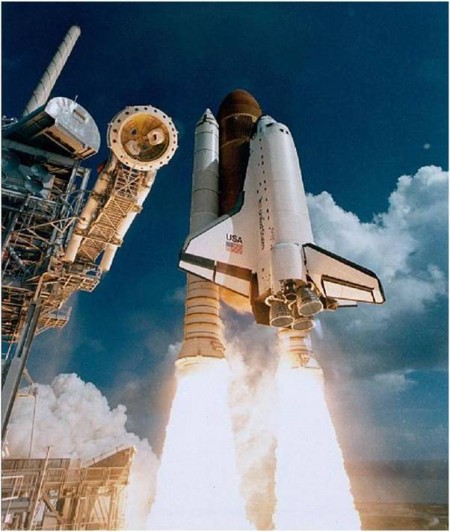Twenty-seven years ago this week, the Space Shuttle Atlantis was launched on its maiden spaceflight. Known as Mission STS-51J, the flight made Atlantis the fourth member of the Space Shuttle Orbiter fleet to reach Earth orbit.
Mission STS-51J marked the twenty-first orbital flight of the Space Shuttle Program. The primary objective of Atlantis’ first mission was to deploy a Department of Defense (DoD) satellite payload to geostationary orbit. The all-military crew included Commander Karol J. Bobko, Pilot Ronald J. Grabe, Mission Specialists David C. Hilmers and Robert L. Stewart, and Payload Specialist William A. Pailes.
Although classified at the time, the STS-51J payload is suspected to have consisted of a pair of Defense Satellite Communications System (DSCS) satellites. The function of these Lockheed-developed spacecraft was to provide a secure communications capability in support of vital military installations situated across the globe.
Atlantis was launched from LC-39A at Cape Canaveral, Florida on Thursday, 03 October 1985. Lift-off time occurred at 15:15:30 UTC. The new orbiter was successfully inserted into a near-circular orbit having a mean altitude of 219-nm. Orbital inclination and period were 28.5-deg and 94.2 minutes, respectively.
Following deployment from Atlantis’ payload bay, a single Boeing Inertial Upper Stage (IUS) successfully propelled the pair of DSCS satellites into geostationary orbit. With each satellite weighing 5,760 lbs, the total DSCS-IUS stack tipped the scales at 44,020 lbs.
Atlantis orbited the globe 64 times before returning to Earth on Monday, 07 October 1985. The Orbiter touched-down on Rogers Dry Lake at Edwards Air Force Base, California at 17:00:08 UTC. Total mission time was 97 hours, 44 minutes and 38 seconds. From lift-off to landing, Atlantis and her crew flew a total distance of 1,462,203 nm.
History records that Atlantis flew 33 (24.4%) of the 135 missions flown over the life of the Space Shuttle Program. During an “operational” flight career spanning 1985 to 2011, Atlantis and her crews contributed immensely to American spaceflight. Key among many accomplishments were helping to build the International Space Station (ISS), refurbishing the Hubble Space Telescope (HST), launching of the Magellan Probe to Venus, and launching the Galileo Probe to Jupiter.
Like her other stable mates, Atlantis no longer graces the heavens with her presence. She had the honor (?) of flying the final Space Shuttle mission (STS-135) in July of 2011. Now eternally rooted to the ground, Atlantis resides on public display at NASA’s Kennedy Space Center (KSC) in Florida.

